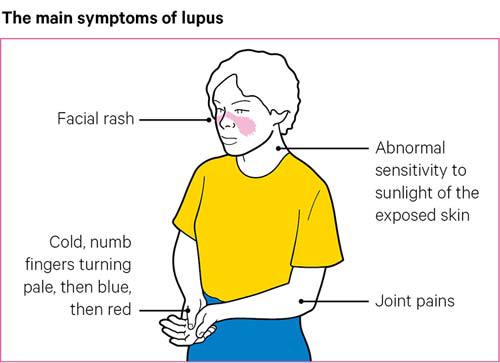Melissa’s advice for managing lupus flare-ups
06 September 2023
Living with lupus can be unpredictable. One day your symptoms might feel under control. Then, the next day, you might have a painful flare-up. This is when your symptoms worsen and feel a bit ill.
Melissa, 25, was diagnosed with lupus (SLE) and diabetes when she just nine years old. Here she shares how she copes with the ups and downs of her condition.
What is lupus?
Lupus is an autoimmune condition. This means the immune system, which is the body’s natural self-defence system, mistakenly attacks the body's own tissues.
There are two main types of lupus:
- discoid lupus
- systemic lupus erythematosus (SLE).
 Lupus can have many different symptoms, but the three most common are:
Lupus can have many different symptoms, but the three most common are:
- joint pain
- skin rashes (a butterfly-shaped rash over the cheeks and nose is common in lupus).
- tiredness (sometimes called fatigue).
Some people with lupus will only have these symptoms, though they can still have a big impact on daily life. Other general symptoms are:
- ulcers in the mouth or nose
- hair loss
- fever
- weight loss
- swelling of the lymph glands, in the neck, armpits or groin, or under the chin
- depression
- anxiety.
Most people will only have one or a few of the possible symptoms, and many people find that the symptoms come and go.
Melissa’s lupus symptoms

Lupus affects everyone differently, but Melissa says her first symptoms were “low weight, fatigue and a butterfly rash.”
“My skin is the major thing that’s affected by lupus,” she says. “The fatigue is also difficult. On a Saturday morning, if I go to a spin class, I come back and need to sleep for the rest of the afternoon.”
Over the years, Melissa has tried different treatments but currently her treatment plan is stable.
“I think that’s because I’ve got a good therapeutic rapport with my rheumatologists and diabetes team.”
How Melissa manages lupus flare-ups
Dealing with pain and fatigue can be challenging, but there are small steps you can take to help you cope. Here Melissa shares her tips and advice.
Understand your triggers
If you have lupus, you might notice that flare-ups tend to happen after a certain action or situation. For example, maybe you feel worse when you’re feeling stressed, exhausted or have an infection. These are sometimes called triggers.
Try to figure out your triggers and reduce them if you can, says Melissa. “Be in tune with your body and trust your intuition. You know when our body is not right, or something is off.”
Record your symptoms
Some people find it helpful to record their symptoms in a diary. That way, you can easily track any changes and share these with your healthcare team.
Melissa suggests taking photos too. “When you describe how your joints felt on a certain day, you don’t get the visual affect. At least, with a photo, you can say this was a 9 out of 10. It was excruciating.”
“I’d also recommend using a pain scale to record how your condition changes day by day. It helps me assess how my pain has affected me.”
Prioritise and pace yourself
Fatigue is different from feeling tired. This is extreme tiredness that doesn’t get better with rest or sleep.
Like many people with lupus, fatigue is a major hurdle for Melissa. But she still finds ways to do the hobbies she enjoys, like her weekly spin class.
“It’s just about pacing yourself,” she explains. “If I’m writing a to-do list, I’ll say ‘Okay what can be done today, what can be done tomorrow and what can be left for next week?’ I’ll try and just do one or two things.”
Manage your stress levels
Over the years, Melissa says she’s learned that “stress is a key trigger” for her lupus. But the good news is she’s found small ways to cope with it.
“I do a gratitude journal in the morning where I’ll write down what I'm grateful for, how my day's gone so far, and I’ll reflect on it,” Melissa says. “It's important to write your worries down because sometimes they can build up.”
Staying active can also be a good stress-buster – and Melissa agrees. “I try to make sure I go out once a day to do something I enjoy, like exercise. I think it's important just to have that headspace for yourself."
Celebrate the small wins
When you’re living with a long-term condition, it’s natural to feel a rollercoaster of emotions.
“Throughout my journey I've had a few flare ups which have involved my skin. Some days I feel frustrated and angry. I think ‘Why did this happen?’” says Melissa.
To combat this, she says “it’s about remembering the small wins.”
"Life throws us curveballs. I had a major flareup in 2014 when I was doing my A-levels. I had a full rash on my face, legs, arms, everywhere.
"[But] now I can look back at the journey I’ve been on and think ‘Your lupus was really challenging at that time and now it’s at more of a stable point.’ I think it’s good to take time to reflect. Some days we don’t reflect on the transition from ‘then’ to ‘now’.”
Get support from friends and family
Melissa says that living with a long-term condition has made her resilient but that it’s important to ask for support when you need it.
If you’re struggling, remember you can always chat to family, friends and your healthcare team. Plus, we can support you too.
When she was diagnosed with diabetes, Melissa says her family took the time to learn how to give her insulin injections, especially when transitioning to an insulin pump. “Now, I'm confident that if I did have a flare up and my joints were sore or my hands or hurting, they would know how to do my insulin.
My sister has lupus, so we often share our thoughts and experiences. We find helpful resources from Versus Arthritis, like their stretching videos.
Get support at work
There are some practical things you can do to help you manage your condition in the workplace, says Melissa.
To help manage her fatigue, Melissa works four days a week instead of five. Plus, she makes sure to take breaks between her meetings, so she can stretch any stiff joints or delayed onset muscle soreness from her spin class.
“I think it's also important to recognise when you don't feel happy in a job for your own mental wellbeing but also your musculoskeletal condition,” she adds.
Be kind to yourself
Being diagnosed with a long-term condition can be nerve-wracking, confusing, or even a bit lonely. If you’re struggling, Melissa says “be kind to yourself and remember you can still do the things you want to do in life, but you might just need to adapt. Just because you need to make changes doesn’t mean you can’t go to university, for example.
“Lupus can be hard at the beginning, but it will get better. It's about working collaboratively with your healthcare team and trying to find a way to do what you enjoy with a bit of adaptation.”
We’re here to help
If you’re under the age of 25 and have arthritis, you can reach out to our Young People and Families Service.
We offer helpful information and support on how to manage your condition. Plus, we put on a range of events across the UK where you can meet other young people with arthritis.
You could also:
- Call our free helpline on 0800 5200 520
- Join our online community
- Stay in touch and follow us on Twitter, Facebook and Instagram.